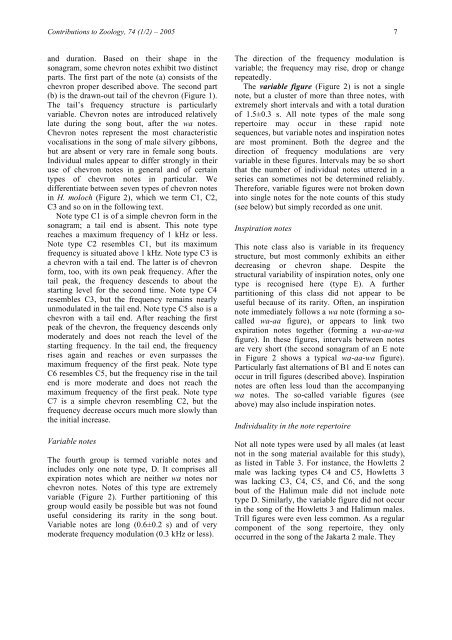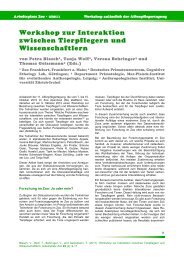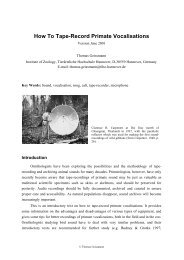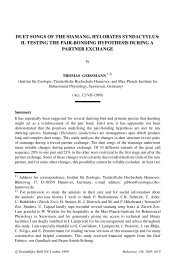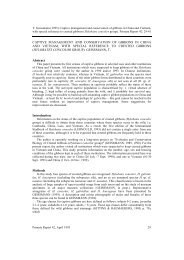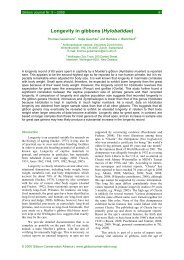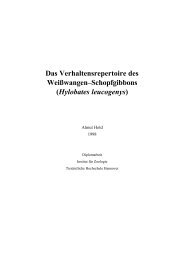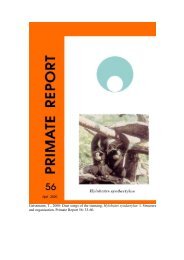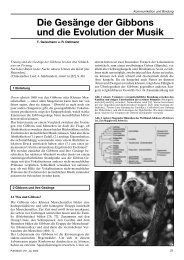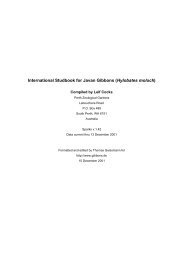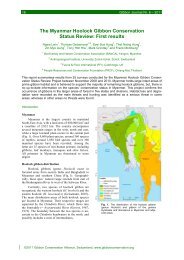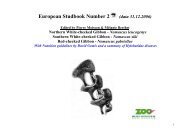The male song of the Javan silvery gibbon (Hylobates moloch)
The male song of the Javan silvery gibbon (Hylobates moloch)
The male song of the Javan silvery gibbon (Hylobates moloch)
- No tags were found...
Create successful ePaper yourself
Turn your PDF publications into a flip-book with our unique Google optimized e-Paper software.
Contributions to Zoology, 74 (1/2) – 2005 7and duration. Based on <strong>the</strong>ir shape in <strong>the</strong>sonagram, some chevron notes exhibit two distinctparts. <strong>The</strong> first part <strong>of</strong> <strong>the</strong> note (a) consists <strong>of</strong> <strong>the</strong>chevron proper described above. <strong>The</strong> second part(b) is <strong>the</strong> drawn-out tail <strong>of</strong> <strong>the</strong> chevron (Figure 1).<strong>The</strong> tail’s frequency structure is particularlyvariable. Chevron notes are introduced relativelylate during <strong>the</strong> <strong>song</strong> bout, after <strong>the</strong> wa notes.Chevron notes represent <strong>the</strong> most characteristicvocalisations in <strong>the</strong> <strong>song</strong> <strong>of</strong> <strong>male</strong> <strong>silvery</strong> <strong>gibbon</strong>s,but are absent or very rare in fe<strong>male</strong> <strong>song</strong> bouts.Individual <strong>male</strong>s appear to differ strongly in <strong>the</strong>iruse <strong>of</strong> chevron notes in general and <strong>of</strong> certaintypes <strong>of</strong> chevron notes in particular. Wedifferentiate between seven types <strong>of</strong> chevron notesin H. <strong>moloch</strong> (Figure 2), which we term C1, C2,C3 and so on in <strong>the</strong> following text.Note type C1 is <strong>of</strong> a simple chevron form in <strong>the</strong>sonagram; a tail end is absent. This note typereaches a maximum frequency <strong>of</strong> 1 kHz or less.Note type C2 resembles C1, but its maximumfrequency is situated above 1 kHz. Note type C3 isa chevron with a tail end. <strong>The</strong> latter is <strong>of</strong> chevronform, too, with its own peak frequency. After <strong>the</strong>tail peak, <strong>the</strong> frequency descends to about <strong>the</strong>starting level for <strong>the</strong> second time. Note type C4resembles C3, but <strong>the</strong> frequency remains nearlyunmodulated in <strong>the</strong> tail end. Note type C5 also is achevron with a tail end. After reaching <strong>the</strong> firstpeak <strong>of</strong> <strong>the</strong> chevron, <strong>the</strong> frequency descends onlymoderately and does not reach <strong>the</strong> level <strong>of</strong> <strong>the</strong>starting frequency. In <strong>the</strong> tail end, <strong>the</strong> frequencyrises again and reaches or even surpasses <strong>the</strong>maximum frequency <strong>of</strong> <strong>the</strong> first peak. Note typeC6 resembles C5, but <strong>the</strong> frequency rise in <strong>the</strong> tailend is more moderate and does not reach <strong>the</strong>maximum frequency <strong>of</strong> <strong>the</strong> first peak. Note typeC7 is a simple chevron resembling C2, but <strong>the</strong>frequency decrease occurs much more slowly than<strong>the</strong> initial increase.Variable notes<strong>The</strong> fourth group is termed variable notes andincludes only one note type, D. It comprises allexpiration notes which are nei<strong>the</strong>r wa notes norchevron notes. Notes <strong>of</strong> this type are extremelyvariable (Figure 2). Fur<strong>the</strong>r partitioning <strong>of</strong> thisgroup would easily be possible but was not founduseful considering its rarity in <strong>the</strong> <strong>song</strong> bout.Variable notes are long (0.6±0.2 s) and <strong>of</strong> verymoderate frequency modulation (0.3 kHz or less).<strong>The</strong> direction <strong>of</strong> <strong>the</strong> frequency modulation isvariable; <strong>the</strong> frequency may rise, drop or changerepeatedly.<strong>The</strong> variable figure (Figure 2) is not a singlenote, but a cluster <strong>of</strong> more than three notes, wi<strong>the</strong>xtremely short intervals and with a total duration<strong>of</strong> 1.5±0.3 s. All note types <strong>of</strong> <strong>the</strong> <strong>male</strong> <strong>song</strong>repertoire may occur in <strong>the</strong>se rapid notesequences, but variable notes and inspiration notesare most prominent. Both <strong>the</strong> degree and <strong>the</strong>direction <strong>of</strong> frequency modulations are veryvariable in <strong>the</strong>se figures. Intervals may be so shortthat <strong>the</strong> number <strong>of</strong> individual notes uttered in aseries can sometimes not be determined reliably.<strong>The</strong>refore, variable figures were not broken downinto single notes for <strong>the</strong> note counts <strong>of</strong> this study(see below) but simply recorded as one unit.Inspiration notesThis note class also is variable in its frequencystructure, but most commonly exhibits an ei<strong>the</strong>rdecreasing or chevron shape. Despite <strong>the</strong>structural variability <strong>of</strong> inspiration notes, only onetype is recognised here (type E). A fur<strong>the</strong>rpartitioning <strong>of</strong> this class did not appear to beuseful because <strong>of</strong> its rarity. Often, an inspirationnote immediately follows a wa note (forming a socalledwa-aa figure), or appears to link twoexpiration notes toge<strong>the</strong>r (forming a wa-aa-wafigure). In <strong>the</strong>se figures, intervals between notesare very short (<strong>the</strong> second sonagram <strong>of</strong> an E notein Figure 2 shows a typical wa-aa-wa figure).Particularly fast alternations <strong>of</strong> B1 and E notes canoccur in trill figures (described above). Inspirationnotes are <strong>of</strong>ten less loud than <strong>the</strong> accompanyingwa notes. <strong>The</strong> so-called variable figures (seeabove) may also include inspiration notes.Individuality in <strong>the</strong> note repertoireNot all note types were used by all <strong>male</strong>s (at leastnot in <strong>the</strong> <strong>song</strong> material available for this study),as listed in Table 3. For instance, <strong>the</strong> Howletts 2<strong>male</strong> was lacking types C4 and C5, Howletts 3was lacking C3, C4, C5, and C6, and <strong>the</strong> <strong>song</strong>bout <strong>of</strong> <strong>the</strong> Halimun <strong>male</strong> did not include notetype D. Similarly, <strong>the</strong> variable figure did not occurin <strong>the</strong> <strong>song</strong> <strong>of</strong> <strong>the</strong> Howletts 3 and Halimun <strong>male</strong>s.Trill figures were even less common. As a regularcomponent <strong>of</strong> <strong>the</strong> <strong>song</strong> repertoire, <strong>the</strong>y onlyoccurred in <strong>the</strong> <strong>song</strong> <strong>of</strong> <strong>the</strong> Jakarta 2 <strong>male</strong>. <strong>The</strong>y


